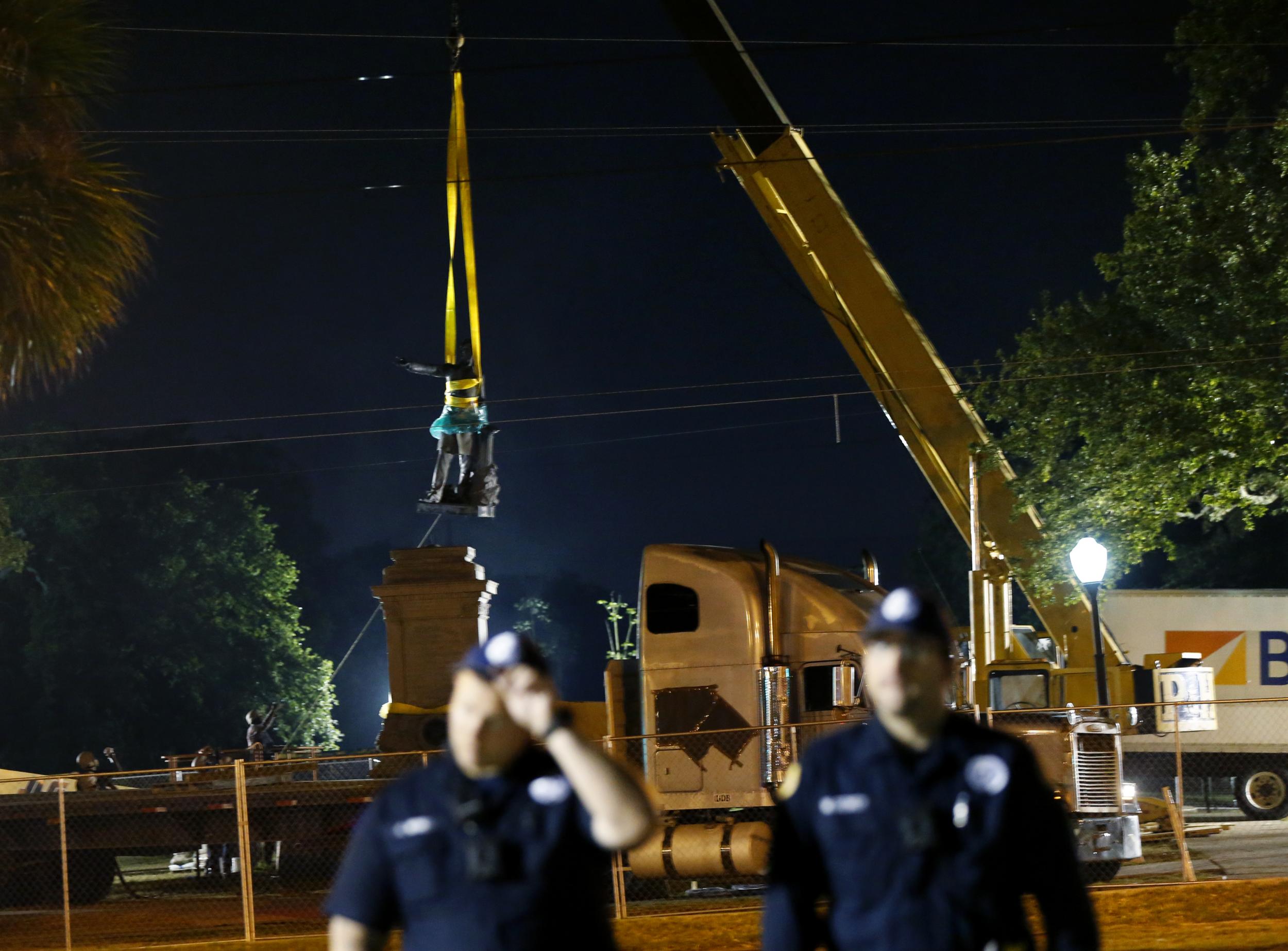New Orleans removes Confederate monument under cover of darkness after receiving death threats
The monument is the second of four to be removed in the city
Your support helps us to tell the story
From reproductive rights to climate change to Big Tech, The Independent is on the ground when the story is developing. Whether it's investigating the financials of Elon Musk's pro-Trump PAC or producing our latest documentary, 'The A Word', which shines a light on the American women fighting for reproductive rights, we know how important it is to parse out the facts from the messaging.
At such a critical moment in US history, we need reporters on the ground. Your donation allows us to keep sending journalists to speak to both sides of the story.
The Independent is trusted by Americans across the entire political spectrum. And unlike many other quality news outlets, we choose not to lock Americans out of our reporting and analysis with paywalls. We believe quality journalism should be available to everyone, paid for by those who can afford it.
Your support makes all the difference.Workers have removed a controversial Confederate symbol in New Orleans under the cover of darkness, but surrounded by throngs of enthusiastic — and also grieving —demonstrators.
A statue of Confederate President Jefferson Davis was hoisted up overnight by workers wearing face masks and what appeared to be tactical vests, highlighting the fierce debate to remove four such statues that has brought death threats aimed at city officials and every crane rental company in southern Louisiana.
Just beyond the chain link fence and barricades installed by police to ensure that simmering tensions didn’t break into a boil, supporters and opponents of removal shouted into the night. In a city known for its musical culture, supporters tapped out beats and chanted anti-white supremacy messages. Across the barrier, opponents chanted “President Davis! President Davis!” in reverence to the symbol some contend represents a cultural history, not one of racism.
“These monuments have stood not as historic or educational markers of our legacy of slavery and segregation, but in celebration of it. I believe we must remember all of our history, but we need not revere it,” New Orleans Mayor Mitch Landrieu said in a statement.
“To literally put the Confederacy on a pedestal in some of our most prominent public places is not only an inaccurate reflection of our past, it is an affront to our present, and a bad prescription for our future. We should not be afraid to confront and reconcile our past,” he said.
The Monumental Task Committee, which wants to preserve Confederate monumnets, had a different take.
"Another historic monument was removed under the cover of darkness using amatuer, masked workers in armour, unmarked vehicles and equipment, and with a heavy law enforcement presence," the group said in a statement. "This time it was of Jefferson Davis, the former President of the Confederacy, but who was also a West Point graduate, a hero of the Mexican-American War, and the United States Secretary of War."
The Jefferson Davis statue was the second out of four monuments set to be removed after the New Orleans City Council endorsed a plan in 2015 to do so. That decision followed an outcry that had spread across the American South in response to the Charleston, South Carolina, church shooting earlier that year in which a white man killed nine black churchgoers hoping to incite a race war. The removal dates for the other two monuments have not been disclosed.
Photos of the Charleston shooter, Dylann Roof, taken prior to the attack showed him posing with a handgun and a small confederate flag. When the Confederate flag was not lowered to half-mast on the South Carolina statehouse house grounds following the shooting — as had been done with the US flag and the state flag in mourning for the victims — those pictures sparked a contentious debate that led then-Governor Nikki Haley to make a strong appeal to legislators that resulted in the flag being removed from the statehouse grounds altogether.
“Moral cowardice requires choice and action. It demands that its adherents repeatedly look away, that they favour the fanciful over the plain, myth over history, the dream over the real,” Ta-Nehisi Coates, a prominent social, cultural, and political writer for the Atlantic wrote following the shooting. “Take down the flag. Take it down now.”
Demonstrators in New Orleans this week echoed those sentiments: "Take 'em down! Take 'em down!" they chanted.
The victory in South Carolina for proponents of removing Confederate symbols from public spaces, state emblems, colleges and historical sites preceded a wave of protest in the region, ultimately leading to decision to remove the statues in New Orleans.

The New Orleans Jefferson Davis monument was dedicated in 1911, just over a half century after the end of the American Civil war and roughly halfway through the era of Jim Crow laws that repressed African Americans in the South through institutionalised racial segregation and other forms of official prejudice.
Jefferson Davis was a US representative and senator from Mississippi who later led the Confederacy during the Civil War. A slave owner himself, memorials and monuments celebrating him in several states — including Texas, Virginia, Washington, and of course Louisiana — have come under fire in recent years.
The New Orleans monument that was taken down has been the subject of frequent vandalism in past years.
The monument was taken to an undisclosed location.

Join our commenting forum
Join thought-provoking conversations, follow other Independent readers and see their replies
Comments